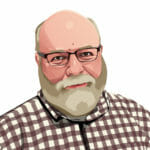
It’s the first command in the Biblical creation story — let there be light. But if you’re working a night shift in a long-term care facility, I need you to stop reading this right now and go turn them all out. Immediately.
All done? Good. Welcome back.
That’s not a request I make lightly. Researchers believe that light exposure of any kind during sleep is linked to obesity, high blood pressure and diabetes in seniors. So congratulations. With that one simple flip of a switch you’re helping save resident lives.
This news hits me hard and personally, because a) I fall dangerously close to the target age of the study — 63 to 84, and b) I don’t think I’ve ever slept in a truly darkened room. Or bought any of those big eye covers. Or put black-out shades on the windows. Or shot out the night light in the hallway with the pistol under my pillow.
In fact, as humans we seem to like keeping a little light on. It’s comforting and hopeful, like the candle burning in the window for the sailor who hasn’t come home after the storm. Darkness equals danger and evil — the shadowy figures in the park, the monster under the bed, the ravenous eyes burning bright in the deep shadows just beyond the dying campfire.
Back to the influence of the Bible on this topic, I grew up being told I was the light of the world, and lustily singing “This Little Light of Mine” with other highly impressionable children. Probably hundreds of times over the course of our childhoods, we tunelessly promised to “let it shine, let it shine, let it shine,” “hide it under a bushel, no!” and not “let Satan blow it out.” My point being that the dependence on light is deeply ingrained. Of course, the Bible also called us “the salt of the earth,” which is bad for blood pressure, too.
So after all that early conditioning and ingrained habits, now we find out it’s the darkness that keeps the demons of disease at bay, and it’s the light that’s actually killing us? That’s difficult to wrap my head around, and probably tougher still to implement on a long-term care campus.
I haven’t personally wandered many facilities late at night, though as poorly as I sleep I certainly have plenty of time. But I assume most resident rooms in buildings not located in rural Montana probably have ambient spill from parking lots and streets, and have night lights to prevent falls. Hallway lights are probably dimmed, but how many doors remain open? And what about light from the TV across the curtain in a shared room? Will nursing staff need to don headlamps like they’re on a cave rescue mission to perform late night care tasks?
In the constant quest for person-centered care, I’m sure light is something you’re already taking into account. But we can always do an even better job at creating more pristinely dark spaces for our residents to get the best and most healthful sleep possible.
With all due respect to the book of Genesis, perhaps it’s time for a supplemental divine directive to enhance the nighttime customer experience in long-term care settings:
Let there not be light.
Things I Think is written by Gary Tetz, a two-time national Silver Medalist and three-time regional Gold and Silver Medal winner in the Association of Business Press Editors (ASBPE) awards program, as well as an Award of Excellence honoree in the APEX Awards. He’s been amusing, inspiring, informing and sometimes befuddling long-term care readers worldwide since the end of a previous century. He is a writer and video producer for Consonus Healthcare Services in Portland, OR.
The opinions expressed in McKnight’s Long-Term Care News guest submissions are the author’s and are not necessarily those of McKnight’s Long-Term Care News or its editors.





